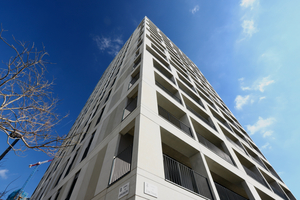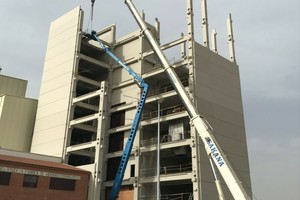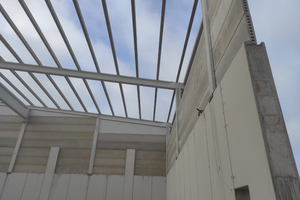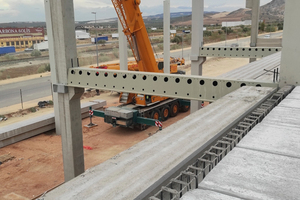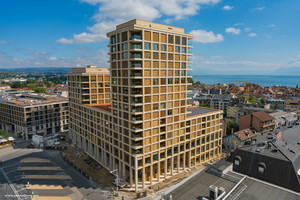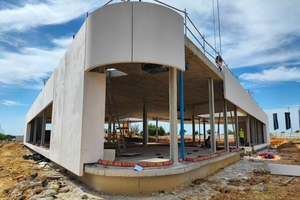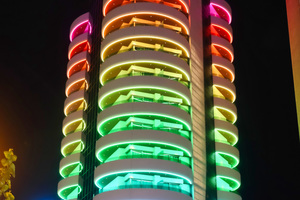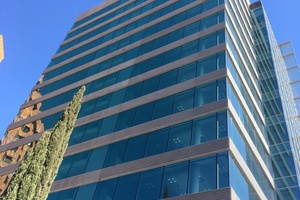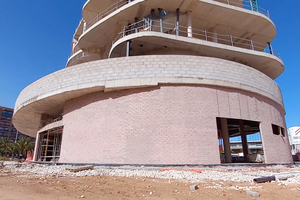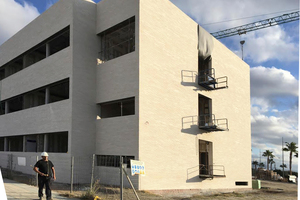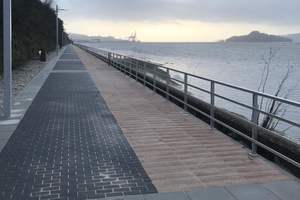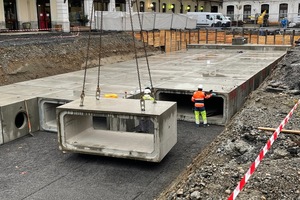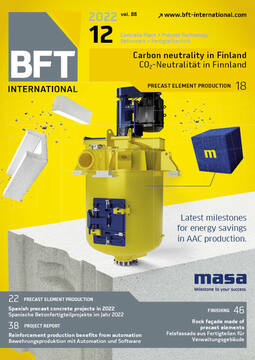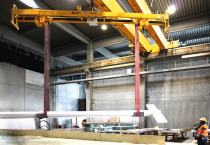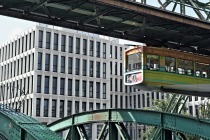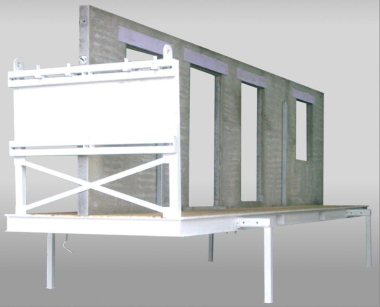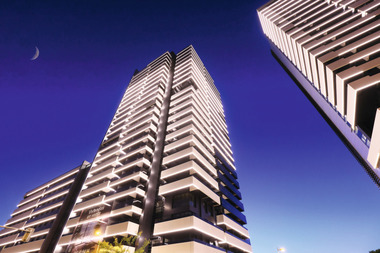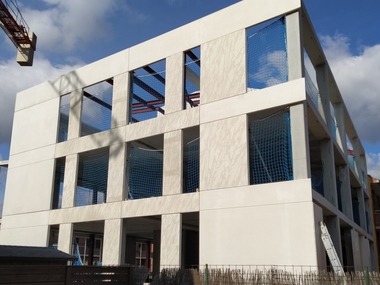Selected example projects with the participation of Spanish manufacturers of precast concrete elements in 2022
The ANDECE Spanish concrete association presents new reference projects on a regular basis, “Projects with surface-refined precast concrete elements in Spain and France“ were published in BFT International 03/2022 last time. This article presents further successful new examples of the past calendar year.
Despite the difficult conditions that affected the general situation in the last few months, not sparing the construction industry either, the precast concrete industry continued to demonstrate its enormous adaptability to new challenges in terms of construction, no matter whether buildings, all kinds of civil infrastructure or rehabilitation of urban areas are concerned. In a context where virtually everybody is talking about concepts like climate neutrality, decarbonization, circular economy or digitization [1], which are leading to new requirements on technology and function, precast concrete elements, in most cases, are an ideal option and even provide a better possibility than other construction methods for building fast, on time, while minimizing waste as well as still at manageable fixed costs.
In the following article, Alejandro Lopéz Vidal, Technical Director of ANDECE, has put together a series of interesting new projects submitted by member companies of the Spanish concrete association [2].
1 Precast concrete structure for a 16-story residential building (Figure 01)
The manufacturer of precast concrete elements ROANSA supplied the concrete elements for the load-bearing structure of an imposing residential building with 16 stories situated at Plaza Europa in L‘Hospitalet de Llobregat (province of Barcelona).
Both precast elements manufactured at the factory and elements produced on site were used here. Two different systems of precast elements were applied: The east and west façades are designed in fair-faced concrete. Columns and beams with bolted connections were used in this case. All curtain wall elements of the north and south façade were produced on site. The special visual appearance of these concrete elements was achieved by an OSB texture in combination with a herringbone texture. This gives the façade its own touch with fulfilling the requirements of the architectural planning entirely.
ROANSA is working in all fields – from the management software to the technical department through to manufacturing, logistics and assembly – with a BIM system. This highly advanced modeling technology allows digitalizing any construction project down to the smallest detail. Hence, precision is guaranteed in manufacture and assembly. Aedas Homes was the property developer; construction works were executed by the Certis construction company.
Manufacturer of precast concrete elements: ROANSA
2 Load-bearing structure for an industrial building in an existing plant (Figure 02)
This construction project in Renedo de Esgueva (province of Valladolid) is challenging if only because an industrial building with a ridge height of more than 40 meters was to be built on a relatively small area in the midst of several existing buildings. For an optimum utilization of the effective area, the load-bearing elements had to be designed as slender as possible, leading to the fact that all stories are designed with rigid connections. Moreover, it was ensured that mainly vertical forces are acting on the foundation. The columns were manufactured in two independent parts being screwed together, thus resulting in supports with a length of more than 40 m. At the level of the respective floor slabs, appropriate recesses for reinforcement were provided so as to form the rigid connections.
All main beams are designed with I-shaped edges depending on the load and the transverse beams have I-shaped cross-sections too. There is a large number of openings on the various levels as lead-through of raw material silos as well as production equipment. The silos are supported by precast concrete beams on which a hollow-core slab with an appropriate compression layer is installed. The curtain wall façade consists of insulated horizontal panels.
Assembly works on the building were a great challenge due to the quite difficult access for cranes and fork-lift trucks and because of ongoing operations of the existing industrial units – according to which the assembly times were determined.
Manufacturer of precast concrete elements: PRAINSA
3 Large-scale use of precast concrete elements for the load-bearing structure of a warehouse (Figure 03)
A new storage facility covering 14,000 m² for fertilizers and chemicals was built in Puerto de Sagunto (province of Valencia). The technical management of the project was in the hands of IMAP Consulting.
A system consisting of double walls being 6.70 m high combined with precast concrete columns fixed by means of threads was used for the erection of this warehouse. The cladding is made of hollow-core slabs which are inserted in the supports and are provided with variable edges of 15 to 20 cm, depending on the spans to be bridged. The small number of interior columns is also noteworthy, with sections bridging spans of 35 m using transverse beams with a height of 1.70 m. Hollow beams with an edge length of 30 cm were used for the roof structure.
Manufacturer of precast concrete elements: FORMAC
4 Bolted connections and Deltabeam composite beams for the load-bearing structure of an industrial building (Figure 04)
This project is the new factory building of Lumon, part of the Finish multinational company located in Antequera (Málaga), a family-owned international group specialized in design, sales, manufacture and installation of frameless balcony and terrace façade products. The production facility is built on a plot of land covering more than 25,000 m². The building has a floor space of nearly 15,000 m² on two floors and an office building, added by a storage as well as loading and unloading areas.
In this project, Peikko has been working together with the Coframar planning office right from the beginning and provided technical support for the calculation and design of the bolted precast column connections. Due to substantial cost and time savings, the decision was made in favor of the Peikko bolted column connections, which moreover ensure absolute safety on the building structure. The HPKM column shoes and the HPM anchor bolts of Peikko are CE marked and have obtained a European Technical Approval (ETA), guaranteeing their properties and technical performance.
In addition, they opted for the use of Deltabeam composite beams of Peikko in an area of the factory, so as to reduce the deflection observed in case of conventional precast concrete beams considerably. Deltabeam composite beams in combination with hollow slabs ensure that construction works can be done quicker, safer and more efficient. Moreover, there is no need for further treatment of the structural components because of the integrated fire protection of the beams. To the utmost satisfaction of the project management, Deltabeam composite beams allowed for realizing completely even heavy-duty floor slabs by means of the beams with integrated fire protection. The precast concrete elements of the load-bearing structure were manufactured and supplied by J. Cicera Arcos.
Manufacturer of precast concrete elements: J. Cirera Arcos
5 Residential building façade made of precast concrete panels in Switzerland (Figure 05)
This building comprises several blocks and five stories; the façade made of self-supporting precast panels (without structural function) is arranged horizontally in the section of the floor slab and vertically in the section of columns and window posts. A white concrete of type HA40/AC/12/IIa colored with a yellow pigment and sand-blasting surface treatment was used here.
The elements in different widths are 8 to 20 cm thick and have cross-sections in various shapes: C-, L- and Z-shaped. The lengths vary considerably, with an average of approx. 3.5 m.
The precast elements are attached at a distance of 29 cm from the load-bearing structure of the building; the space between them is filled with insulating material on the construction site. Stainless steel screw connections were selected as fastening system, suspended fixings for the outer shell in front of the columns and Omega brackets for the outer shell in front of the slab edge cladding.
Installation was carried out from outside; for this purpose, scaffolding was erected along the entire width of the façade.
Manufacturer of precast concrete elements: INDAGSA (Grupo Ortiz)
6 Curved panel for the outer shell of a club house (Figure 06)
Why are curved shapes so attractive when building with concrete? Why do all non-rectangular shapes catch the eye directly? For the social club of the Aliaga community of Aedas Homes in Mairena del Aljarafe (Sevilla), the architect Juan M. Lahuerta Casanova has designed a building with a floor plan in the shape of an equilateral triangle with rounded corners, with entrances in the shape of an equilateral triangle and courtyards, in which the same shape is repeated. The outer shell of the building erected by Jarquil Construcción consists of precast panels made of white concrete; the panels were produced with the aid of casting molds.
Manufacturer of precast concrete elements: Prefabricados Hermanos Quijada
7 1.800 m² of double-curved GRC sandwich panels used for a hotel (Figure 07)
The Arcos Gold Hotel in Benidorm (Alicante) appears as a 14-story tower with an overall height of 60 m above ground level. The floor space consists of three circles which unit in a central part. Two of this circles have an identical radius, the third one is somewhat larger. The semicircles protruding outwards from the central part create spacious terraces which belong to the rooms.
The client was looking for a solution using precast concrete elements for the terrace balustrades; however, he was not sure whether they could be designed as double-curved elements. When Prefabricados Ponce received the request for an investigation, it was even considered modifying the original concept with curved balustrades to straight ones, which would have made the project less attractive. When the technical proposal was submitted, the manufacturer of precast concrete elements, based on its experience, committed to design the façade with double-curved GRC sandwich panels (1,800 m² in a white smooth finish), which also included a solution for anchoring small glass balustrades on the top floor which would be visible on the rear side. The manufacturer managed to execute all balustrades as originally planned by architect José Manuel Escobedo Pérez in accordance with the customer‘s request.
Manufacturer of precast concrete elements: Prefabricados Ponce
8 Refurbishment of a building façade using concrete panels (Figure 08)
Self-supporting concrete panels are a robust, fast, sustainable, energy-efficient and noise-insulating solution for the renovation of buildings. This is one of the fields, in which the construction industry is expecting an increase in the number of orders in the next few years, so as to comply with the stipulations for the renewal of the building stock.
For a total area of 865 m² of this building situated in Madrid‘s Calle Cardenal Marcelo Spínola, 132 self-supporting concrete panels with a thickness of 140 mm were installed. Gray cement with 2 % of a black color pigment and a hydrophobic treatment were used in the production of the concrete. Only four molds were needed and the surface texture was achieved by the rubber formliner „Rib Type C“ as well as fine sandblasting. In addition, concrete elements were supplied for the staircases. The design came from L35 Arquitectos S.A.P. and site manager was José Luis Querol.
Manufacturer of precast concrete elements: PREHORQUISA
9 Acoustic concrete blocks for a new student dormitory (Figure 09)
Tabicem supplied acoustic concrete blocks for the new student dormitory in the university town of Elche (province of Alicante). The decision was made in favor of this material because it even more than fulfils the current construction regulations. The Tabicem Acstico block offers noise protection up to 52 dB, thus being an optimum alternative to other building materials as clay bricks, for example. Therefore, the Tabicem Acstico block is the ideal solution for a student dormitory, where noise protection is particularly important.
The block captivates with its reddish color; moreover, the blocks are tested and certified, which gives the walls aesthetic added value. In addition, the silo mortar of Tabicem Acoustic was used which was tested together with Tabicem Acoustic and ensures an optimum performance.
Besides the cost savings, this brick also led to a considerable improvement of the building‘s carbon footprint. As can be seen from the environmental statements created with the ANDECE tool, the Tabicem Acstico block reduces the CO2 emissions additionally. Moreover, recycling will be easier at the end of the building‘s service life, because cement-based materials were used exclusively.
Concrete block manufacturer: TABICEM
10 White concrete blocks for the envelope of a secondary school (Figure 10)
Blocks of the „Coupe“ line made by Bloques Barruca were selected for the building envelope having a total area of almost 1,900 m² of a secondary school in San Pedro de Alcántara in the province of Málaga. The building was provided with energy-efficiency measures, such as shading, careful avoidance of thermal bridges, a system for the generation of solar energy and a building envelope adapted to the climate of the small town. The education authority of the regional government in Andalusia decided to use the white concrete blocks, among others, because of the ability to maintain the inside temperature thanks to the reflection of the concrete block and to use its thermal inertia for cooling in the summer and saving heating costs in winter. This is one of the advantages supporting the architectural offices of Fresneda & Zamora and AV-13, because the type of block was not only chosen for its planimetry, strength and fast installation, but also because of its design.
The idea, moreover, was to revive the traditional construction with concrete masonry what inspired the clients to employ local workers, to use sustainable materials allowing saving of larger amounts of water in the production and installation as well as a long-term durability as the façade – according to the principles of circular economy – is fully recyclable when it need to be replaced eventually. This construction project was started by the ANFRASA construction company in November 2020 and was completed in June 2022.
Concrete block manufacturer: Bloques Barruca
11 Concrete paving blocks, concrete flagstones and concrete curbstones for a pedestrian promenade (Figure 11)
Sanjosé Constructora executed the works on the promenade between the towns of Marín and Pontevedra on the Galician coast (north-west of Spain). The walkway and the bicycle path run over a length of 1,200 meters and a width of 4.4 meters, which connect the current promenade of Avenida de Marín in Pontevedra with the Rotonda de Celulosa. The promenade follows the course of the coastline along road PO-12 and PO-11.
The pavement for this public construction contract – concrete paving blocks and concrete flagstones with double coating and partially in a wooden look as well as the concrete curbstones – were supplied by Pretensados Campo. The pavements selected exactly comply with requirements of the contracting authority: In fact, a promenade should be realized with a naturally appearing pavement that blends into its environment and that requires only minimum maintenance.
Concrete block manufacturer: Pretensados Campo
12 Retention basin beneath a parking lot made of reinforced-concrete box culverts (Figure 12)
The Communauté d‘Agglomération municipality association of Pau Béarn Pyrénées in the Departement Pyrénées-Atlantiques in the French region of Nouvelle Aquitaine was the initiator for planning a multimodal transport hub at the Pau railway station, so as to become the most important gate to Béarn and thus creating the main tool for the development of a „soft mobility“ and of regional public transport.
In the first project phase in 2021, among other things, a retention basin (Bassin Parvis) was realized beneath one of the bus parking lots of the railway station. PPALAU assumed the production of the retention basin. This was built by means of box culverts made of reinforced concrete with internal dimensions of 3,000 x 1,000 mm and was installed in several steps. A total of 160.95 running meters of box culvert elements were supplied. However, PPALAU not only assumed the manufacture, but beforehand also the calculation according to the French standards and the supply of the curbing.
Manufacturer of precast concrete elements: PPALAU
13 Conclusion
The projects presented in this article show diverse solutions made of precast concrete elements and concrete products used for quite different applications in construction such as a pedestrian walkway, a building façade or a retention basin and provide an impressive evidence of the versatile fields of application of concrete as building material and of precast elements as construction technology. This shows once again how efficiently the industry is able to respond to the requirements of projects more and more characterized by technology and digitalization, which are moreover dominated by the criterium of sustainability for the maximum consideration of ecological, social and economic concerns.
CONTACT
ANDECE
Industría Prefabricado Hormigón
C/Diego de León 47
Edificio Melior
28006 Madrid/Spain
+34 913 238 275
LITERATURE/REFERENCES
de-negocios/

